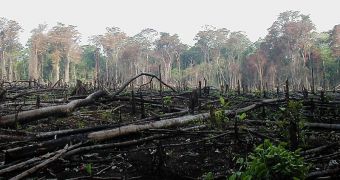At this point in time, 30% of our planet's entire surface is covered by woodland. Despite its influence upon the environment, deforestation implied by agriculture, mining, the fuel and construction industry has a significant effect upon the way our future will look like.
What may actually take us by surprise is the fact that 60% of deforestation takes place in seven countries all across the globe, which will most likely evolve without embracing green values in the near future.
Indonesia, China, U.S., Canada, Russia, Latin America, and the Democratic Republic of Congo in Africa are the seven nations which think that their development can be performed at the environment's expense.
Dangerous precedents have taught us the valuable lesson of environmental preservation, but, despite this fact, deforestation operations continue at alarming rates every year.
The Atlantic forest in Brazil, which used to cover one million square kilometers has managed to conserve only 5% out of its initial surface. Scientists say that, after 1950, the extended industrialization made us say goodbye to two thirds of the forests available in Central America.
It is generally known that our natural resources are limited and have to face an enormous demand which reaches higher rates every year. This tremendous pressure has made the rainforests occupy less and less surfaces throughout time, making their presence shrink from 14% to only 6%.
At the same time, experts warn that, if human activity follows the same path, rainforests will go extinct in about 100 years. This forecast is disturbing, but scientists highlight the seriousness of the situation by adding that a thousand acres of jungle disappear every second.
Furthermore, deforestation leads to desertification. Forests are very important in the entire water cycle. Once trees go down the soil remains unprotected and faces the direct influence of the sun, therefore it is exposed to extreme temperatures which leave it dry and sterile.
Also, deforestation has been correlated with extreme natural phenomena, which trigger significant material losses and deaths, like floods, storms, fires or cyclones. Forests act like huge sponges which take out of the atmosphere a significant amount of CO2 and greenhouse gases.
If the woodland is stopped from playing its part in this environmental equation, the growing amount of polluters will decrease the air quality, and lead to such devastating catastrophes.
The human impact upon surfaces covered by forests can't be separated from the influence it has upon the creatures that consider woodlands their habitat.
Experts say that the jungles shelter up to 70% of the known species of plants and animals. If their habitat is wiped off the face of the earth some may adapt, but others will go extinct.
Since deforestation has been previously linked to deforestation, increasing temperatures will make the arid habitat unbearable for several creatures, therefore the fact that 50,000 species of animals and plants meet their death every year shouldn't come as a surprise.

 14 DAY TRIAL //
14 DAY TRIAL //